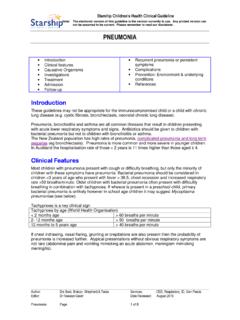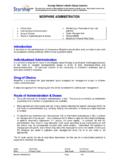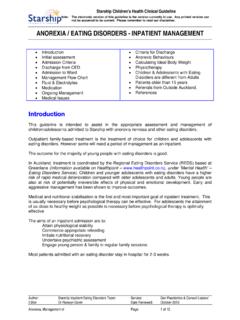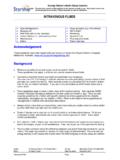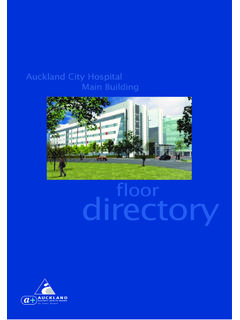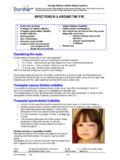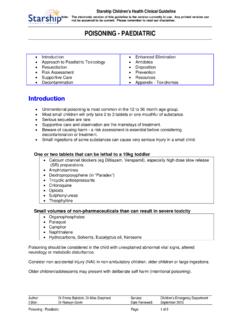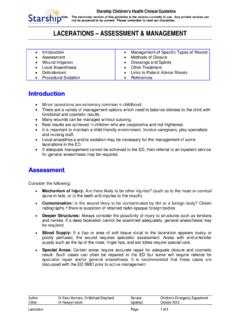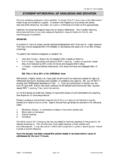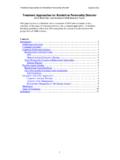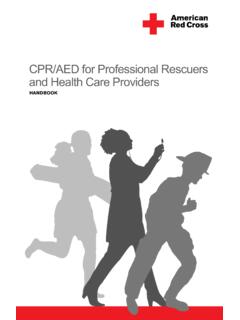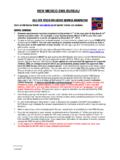Transcription of CARDIOPULMONARY RESUSCITATION (CPR)
1 Starship Children s health Clinical Guideline Note: The electronic version of this guideline is the version currently in use. Any printed version can not be assumed to be current. Please remember to read our disclaimer. CARDIOPULMONARY RESUSCITATION (CPR) Author: D Dr M Shepherd & Dr D Rasanathan Service: CED, Paeds RESUSCITATION Committee Editor: Dr G Nuthall Date Reviewed: August 2011 CARDIOPULMONARY RESUSCITATION (CPR) Page: 1 of 12 Alert the Emergency Team Algorithm ABC Assess & Manage Defibrillation Medications Disability Exposure Secondary Survey Emergency Team Roles Medical Emergency Team Roles - Nursing Role in Wards Post- RESUSCITATION Management Ceasing RESUSCITATION Efforts Parents & Family Documentation Requirements for Deceased Patients References Appendix 1 - AEDs Appendix 2 Intraosseus Insertion Alert the Emergency Team.
2 Dial 777 Specify PAEDIATRIC CODE BLUE ( Paediatric Arrest) Tell the operator the following information H Hospital Starship and whether adult or paediatric patient E Extension you are calling from L Location 24B room 6 P Problem paediatric code blue Drug Calculator: A calculator for Paediatric RESUSCITATION Drug doses can be found on the ADHB Intranet at L:Groups\EVERYONE\Starship\Paed Resus Form These guidelines apply to the RESUSCITATION of infants (beyond the newborn period) and children (until puberty) For neonatal RESUSCITATION please refer to For adult RESUSCITATION please refer to Adult CPR guideline Disclaimers: This guideline is intended for health professional use in the hospital RESUSCITATION setting.
3 Lay rescuers should refer to the NZRC guideline: Starship Children s health Clinical Guideline Note: The electronic version of this guideline is the version currently in use. Any printed version can not be assumed to be current. Please remember to read our disclaimer. CARDIOPULMONARY RESUSCITATION (CPR) Author: D Dr M Shepherd & Dr D Rasanathan Service: CED, Paeds RESUSCITATION Committee Editor: Dr G Nuthall, Dr R Gavin Date Reviewed: August 2011 Cardio-pulmonary RESUSCITATION Page: 2 of 12 Algorithm Starship Children s health Clinical Guideline Note: The electronic version of this guideline is the version currently in use.
4 Any printed version can not be assumed to be current. Please remember to read our disclaimer. CARDIOPULMONARY RESUSCITATION (CPR) Author: D Dr M Shepherd & Dr D Rasanathan Service: CED, Paeds RESUSCITATION Committee Editor: Dr G Nuthall, Dr R Gavin Date Reviewed: August 2011 Cardio-pulmonary RESUSCITATION Page: 3 of 12 ABC - Assess and Manage Ideally the assessment and management of Airway, Breathing and Circulation should occur simultaneously Airway Position head to open obstructed airway ( neutral position, not excessively extended or flexed) Immobilise cervical spine if trauma Jaw thrust or chin lift if still obstructed Suction under direct vision if necessary Place a Guedel airway if appropriate Intubate if necessary (Note that intubation should only be performed by proficient personnel and should not delay other RESUSCITATION efforts.)
5 It will usually be performed after basic life support has been initiated.) Endotracheal Tube size estimated by [(Age(years)/ 4 )+4] - uncuffed [(Age(years)/ 4 )+ ] - cuffed Breathing If absent or ineffective, start ventilation with a blob mask or bag mask ventilation if competent 2 initial breaths If patient has adequate respiratory effort place in high flow (>10 L/minute) oxygen via mask During active RESUSCITATION the highest available concentration of oxygen should be given End Tidal CO2 continuous End Tidal CO2 monitoring should be used wherever possible No End Tidal CO2 with chest compressions suggests lack of ventilation check airway (Endotracheal Tube)
6 And ventilation Low End Tidal CO2 suggests inadequate chest compressions, excessive ventilation or a reversible cause like pneumothorax or hypovolaemia or tamponade High End Tidal CO2 suggests inadequate ventilation Return of spontaneous circulation may be identified by rapid rise in end tidal CO2 Starship Children s health Clinical Guideline Note: The electronic version of this guideline is the version currently in use. Any printed version can not be assumed to be current. Please remember to read our disclaimer. CARDIOPULMONARY RESUSCITATION (CPR) Author: D Dr M Shepherd & Dr D Rasanathan Service: CED, Paeds RESUSCITATION Committee Editor: Dr G Nuthall, Dr R Gavin Date Reviewed: August 2011 Cardio-pulmonary RESUSCITATION Page: 4 of 12 Circulation PUSH HARD, PUSH FAST, DON T STOP Compression Rate Compression/Respiration ratio 100/minute 15.
7 2 Check for signs of circulation o Unresponsive, absent or ineffective breathing o This may include feeling for a brachial or femoral pulse, if absent or inadequate ( less than 60/minute) commence external cardiac compressions o If there is any doubt regarding the presence of adequate circulation, then chest compressions must be started The lower sternum should be compressed by at least 1/3 of the AP diameter, >5cm (>4cm in infants). DO NOT INTERRUPT compressions Pauses should be brief (ideally <10secs) and only to ascertain presence of a pulse and assess the rhythm or to allow intubation or defibrillation If patient is on a bed, a CPR board should be placed under the patient as soon as possible Swap in a new person to deliver compressions at frequent intervals (2mins)
8 To avoid inadequate compressions due to rescuer fatigue Ensure recoil of chest as well as compression NEVER INTERRUPT CPR FOR MORE THAN 10 SECONDS EXCEPT FOR DEFIBRILLATION Obtain ECG rhythm This will normally occur simultaneously with above manoeuvres or as soon as equipment arrives. Monitoring must be done with a monitor or the manual defibrillator not an Advisory External Defibrillators (AED). Defibrillation Early defibrillation is associated with improved outcome consider this as early as possible in the management sequence if the rhythm is suitable for defibrillation.
9 DC shocks for VF and VT should be delivered asynchronously, at a dose of 4J/kg Adhesive pads should be used (instead of paddles) whenever possible See Appendix 1 for information on Advisory External Defibrillators (AEDs). Starship Children s health Clinical Guideline Note: The electronic version of this guideline is the version currently in use. Any printed version can not be assumed to be current. Please remember to read our disclaimer. CARDIOPULMONARY RESUSCITATION (CPR) Author: D Dr M Shepherd & Dr D Rasanathan Service: CED, Paeds RESUSCITATION Committee Editor: Dr G Nuthall, Dr R Gavin Date Reviewed: August 2011 Cardio-pulmonary RESUSCITATION Page: 5 of 12 Medications Obtain venous access Attempt to obtain IV access in a large vein (antecubital fossa, external jugular vein) or place an intraosseous (IO) needle.
10 If no success within 1 minute (usually = 1 attempt) proceed to IO. See Appendix 2. All fluids and all medications on the algorithms can be given via IO route (these need to be pushed as will not run in without pressure). Obtaining venous access should take place simultaneously with other aspects of RESUSCITATION . Initial drugs (epinephrine (adrenaline), atropine, and naloxone) can be given via ET tube pending intravenous access. Dosing should be based on weight, length is the best method for estimating weight. Medication selection Follow the appropriate algorithm based on the ECG rhythm High dose adrenaline should not be used (associated with worse outcomes) Calcium should not be used routinely (associated with worse outcomes).
